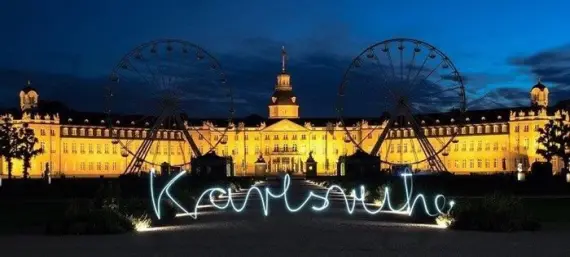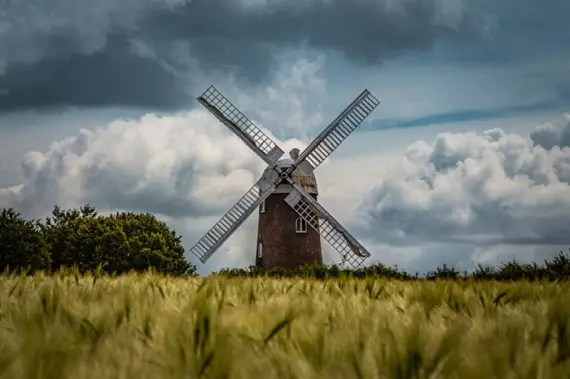Bus from KARLSRUHE to OZIMEK. Current connections
KARLSRUHE

Karlsruhe is a city in Baden-Württemberg in southwestern Germany. It lies in the Upper Rhine Plain, on the Rhine, Alb and Pfinz rivers. It was founded in 1715 by the Margrave of Baden, Karl Wilhelm von Baden-Durlach. What undoubtedly distinguishes the city is its layout in the classic star-shaped layout. At the center is the palace, from which 32 avenues descend radially.
Already in the 19th century Karlsruhe was an important European scientific center. Research on electromagnetic waves was conducted there by Heinrich Hertz, and Karl Drais constructed the first bicycle in 1817. The city is home to Germany's oldest technical university.
What to see in Karlsruhe?
One of the most important sights in the city is the Renaissance palace located in the center. Its interiors now house the Baden State Museum with collections on the region and Karlsruhe itself. This castle is surrounded by an extensive park with a botanical garden and other thematic gardens, where you can have a nice rest amidst the greenery. Another museum worth visiting is the Staatliche Kunsthalle Karlsruhe, with a valuable collection of paintings by such famous artists as Rembrandt, Dürer and Cézanne, among others.
Getting there and transportation - Karlsruhe
The city is well connected - important highways such as the A5, A8 and A65 pass close by, and the French border is only about twenty kilometers away. Karlsruhe's location on the Rhine makes the city an important inland port, the fourth largest in Germany.
The city is also a major rail hub with a freight station where numerous lines converge, including those from Heidelberg to Basel and Mannheim to Rastatt. The Karlsruhe bus station is located near the city's main train station - Karlsruhe Hauptbahnhof on Schwarzwaldstrsse. Sindbad offers numerous buses to Karlsruhe - an affordable and environmentally friendly option for getting to this German city.
Karlsruhe is a city in Baden-Württemberg in southwestern Germany. It lies in the Upper Rhine Plain, on the Rhine, Alb and Pfinz rivers. It was founded in 1715 by the Margrave of Baden, Karl Wilhelm von Baden-Durlach. What undoubtedly distinguishes the city is its layout in the classic star-shaped layout. At the center is the palace, from which 32 avenues descend radially.
Already in the 19th century Karlsruhe was an important European scientific center. Research on electromagnetic waves was conducted there by Heinrich Hertz, and Karl Drais constructed the first bicycle in 1817. The city is home to Germany's oldest technical university.
What to see in Karlsruhe?
One of the most important sights in the city is the Renaissance palace located in the center. Its interiors now house the Baden State Museum with collections on the region and Karlsruhe itself. This castle is surrounded by an extensive park with a botanical garden and other thematic gardens, where you can have a nice rest amidst the greenery. Another museum worth visiting is the Staatliche Kunsthalle Karlsruhe, with a valuable collection of paintings by such famous artists as Rembrandt, Dürer and Cézanne, among others.
Getting there and transportation - Karlsruhe
The city is well connected - important highways such as the A5, A8 and A65 pass close by, and the French border is only about twenty kilometers away. Karlsruhe's location on the Rhine makes the city an important inland port, the fourth largest in Germany.
The city is also a major rail hub with a freight station where numerous lines converge, including those from Heidelberg to Basel and Mannheim to Rastatt. The Karlsruhe bus station is located near the city's main train station - Karlsruhe Hauptbahnhof on Schwarzwaldstrsse. Sindbad offers numerous buses to Karlsruhe - an affordable and environmentally friendly option for getting to this German city.
OZIMEK

Ozimek is a town of less than 9,000 people in Opolskie Province, 21 kilometers east of Opole, 6 kilometers from the popular Turawa Lakes. It lies on the Opole Plain, on the Mała Panwa River. Originally Ozimek was called Małpądew, and later Małpanew, due to its location on the Mała Panwia River. The name Ozimek is most likely derived from the name of the owner of a nearby mill, and over time came to be used to refer to the industrial settlement next to a steel mill established in the second half of the 18th century.
The village's biggest attraction is the oldest iron suspension bridge in Europe, dating back to 1827, crossed over the Mała Panew River. The nearby 19th-century Evangelical Augsburg Church is also worth seeing. A major attraction in the area is also Jurapark Krasiejów, which combines the study of prehistory and evolution with entertainment for the whole family.
Ozimek can prove to be an attractive destination not only for those who love history and technological monuments. It is also an excellent starting point for those who enjoy hiking and biking. In addition, Turawskie Lake is a great place for fishing and water sports, and Mała Panew provides opportunities for canoeing.
Getting to Ozimek
A national and provincial road runs through Ozimek, and the town is close to the A4 highway. There is a railroad station in the city and an Ozimek PKS bus stop located on Kolejowa Street near the iron suspension bridge. There are buses running from it on local as well as national and international routes. You can check all available bus tickets and connections on our website.
Ozimek is a town of less than 9,000 people in Opolskie Province, 21 kilometers east of Opole, 6 kilometers from the popular Turawa Lakes. It lies on the Opole Plain, on the Mała Panwa River. Originally Ozimek was called Małpądew, and later Małpanew, due to its location on the Mała Panwia River. The name Ozimek is most likely derived from the name of the owner of a nearby mill, and over time came to be used to refer to the industrial settlement next to a steel mill established in the second half of the 18th century.
The village's biggest attraction is the oldest iron suspension bridge in Europe, dating back to 1827, crossed over the Mała Panew River. The nearby 19th-century Evangelical Augsburg Church is also worth seeing. A major attraction in the area is also Jurapark Krasiejów, which combines the study of prehistory and evolution with entertainment for the whole family.
Ozimek can prove to be an attractive destination not only for those who love history and technological monuments. It is also an excellent starting point for those who enjoy hiking and biking. In addition, Turawskie Lake is a great place for fishing and water sports, and Mała Panew provides opportunities for canoeing.
Getting to Ozimek
A national and provincial road runs through Ozimek, and the town is close to the A4 highway. There is a railroad station in the city and an Ozimek PKS bus stop located on Kolejowa Street near the iron suspension bridge. There are buses running from it on local as well as national and international routes. You can check all available bus tickets and connections on our website.
© 2025 Sindbad
Technical support, assistance, payments: Sindbad IT
© 2025 Sindbad
Technical support, assistance, payments: Sindbad IT
